What Is Hyperthyroidism in Cats?
Hyperthyroidism in cats (also called hyperthyroid disease) occurs when a feline’s thyroid glands produce too many thyroid hormones (known as T3 and T4). As a result, the metabolic rate increases. An overactive metabolism can negatively affect almost all organs, including the heart, skin, kidneys, and gastrointestinal system.
Every feline has two thyroid glands located in the neck. If one or both of these glands become enlarged, they overproduce T3 and T4. In the majority of cases, the enlarged thyroid is caused by a noncancerous tumor (adenoma). In rare cases, malignant tumors (thyroid adenocarcinomas) may be the reason for the enlargement.
Hyperthyroidism is a common disease in middle-aged or senior cats. The average age of felines with hyperthyroid disease is 13 years old, with only 5% of cases occurring in felines younger than 10. Although any breed of cat can potentially develop hyperthyroidism, some breeds—including Siamese, Burmese, Persian, Himalayan, and Abyssinian cats—are less likely to contract the disease.
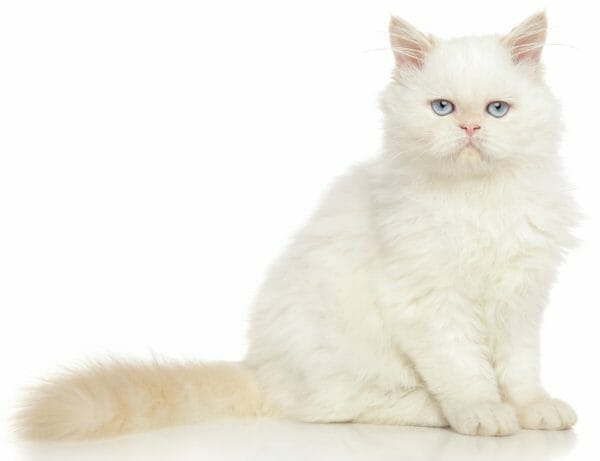
What Causes Hyperthyroidism in Cats?
Although the exact causes of hyperthyroid disease are unknown, some contributing factors include:
- Ongoing exposure to thyroid-disrupting chemicals in the food or environment. One possible culprit is polybrominated diphenyl esters (PBDE)—a class of flame retardants used in a variety of consumer products.
- The lack of or an excess of certain compounds in the diet, such as dietary iodine.
This endocrine disease was diagnosed for the first time in 1978. Some experts believe that felines who eat canned foods (especially canned fish) have a higher risk of developing hyperthyroidism.
Hyperthyroidism in Cat Prognosis
The good news is that hyperthyroidism is treatable, and most cats experience excellent outcomes. Cats that receive radioactive iodine therapy or surgery usually return to normal within a few weeks. Felines treated with medication or a special diet also thrive as long as the drug or diet is consistently given and a vet regularly checks the cat’s thyroid levels.
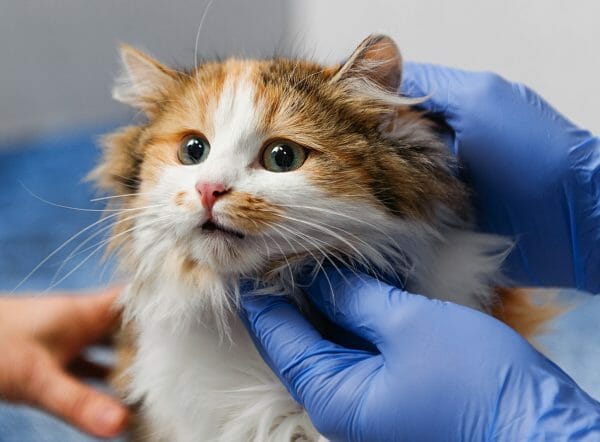
What Happens If Hyperthyroidism In Cats Is Not Treated?
If hyperthyroidism in cats is left untreated, the disease will progress and will eventually result in death. The cat will experience severe weight loss (even if eating regularly or more than usual) and are at risk of developing serious secondary conditions, such as hypertension (high blood pressure) and thyrotoxic cardiomyopathy (a form of heart disease). All of these conditions are reversible with appropriate treatment.
Some pet owners ask about when to euthanize a cat with hyperthyroidism. Euthanizing a feline because of a hyperthyroidism diagnosis is unnecessary because the disease is treatable and the majority of cats have good outcomes. However, if a senior cat is experiencing a host of other health problems on top of hyperthyroidism, owners must make the decision that is best for the animal. A veterinarian can provide guidance and support when making this difficult decision.
Hyperthyroidism in Cats Symptoms
The effects of hyperthyroidism in cats can be quite subtle at the start of the disease. For this reason, a routine thyroid screening for senior cats is recommended. However, over time, the symptoms will get more severe as the disease progresses.
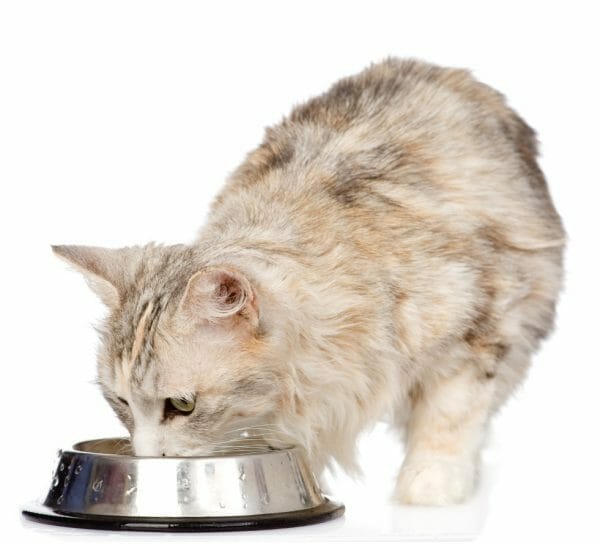
In the early stages of the disease, felines may experience symptoms such as:
- Weight loss despite an increased or normal appetite (the most common sign)
- Enlarged thyroid gland in the neck
- Fast heart rate
- Behavior changes (such as hyperactivity, nervousness, restlessness, crankiness, or aggression)
- Increased drinking or thirst, resulting in increased urination (in both volume and frequency)
- Increased vocalization (especially at night)
As the disease progresses, the symptoms listed above may worsen. Signs of late-stage hyperthyroidism in cats include:
- Extreme weight loss
- Gaunt appearance and sunken eyes
- Severe lethargy
- Loss of appetite
- Rough hair and a coat that appears greasy, unkempt, or matted
- Heart, liver, and kidney disease
Felines with hyperthyroidism may also have difficulty breathing, seizures, uncontrollable vomiting or diarrhea, crying from pain, and collapse. If any of these symptoms occur, the feline should be taken to a vet immediately.
How to Diagnose Hyperthyroidism in Cats
A veterinarian will conduct several tests to diagnose hyperthyroid disease. A physical exam will involve palpating the feline’s neck to see if the thyroid gland is enlarged and checking heart rate and blood pressure. If hyperthyroidism is suspected, a vet may order the following diagnostic tests:
- Blood chemistry panel to measure thyroid hormone levels. An elevated level of total thyroxine (TT4) is common in hyperthyroid disease. However, if TT4 is within normal ranges but the feline still shows signs of hyperthyroidism, the vet may also conduct a FT4 by ED test or a T3 suppression test. If questions persist, a thyroid scan may be performed at a specialty clinic.
- Urinalysis
- Ultrasound of the heart (because high blood pressure and heart disease are common complications of hyperthyroid disease).
Hyperthyroidism in Cats Treatment
The treatment options for cats with hyperthyroid disease include medication, radioactive iodine therapy, surgery, or dietary therapy. Determining how to treat hyperthyroidism in cats will be a joint decision between the owner and the veterinarian based on the cat’s symptoms, co-morbidities, overall health, age, and budget constraints.
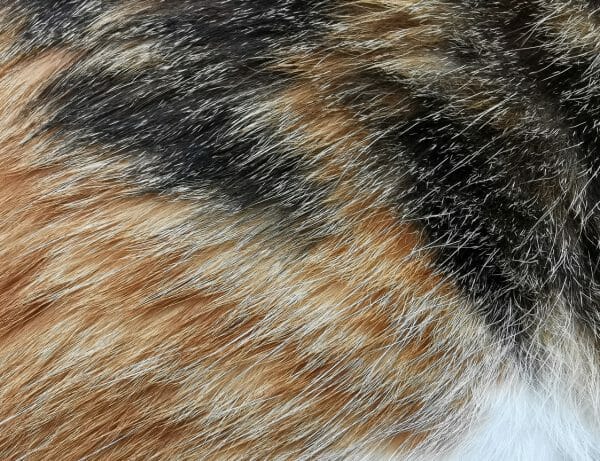
Hyperthyroidism in Cats Medication
An anti-thyroid drug called Felimazole Coated Tablets (methimazole) is the only FDA-approved drug for treating hyperthyroidism in cats. This drug reduces the production and release of thyroid hormones. Although methimazole does not cure the disease, it helps manage the condition. The drug is fairly inexpensive but requires lifelong treatment of two doses every day.
Side effects of methimazole may include vomiting, lethargy, fever, and anemia. However, methimazole is the first-line treatment for most felines and may be used to stabilize a cat before surgery.
Another possible side effect of this medication is that it might work too well and cause the cat to have the opposite condition of hypothyroidism, which is when the thyroid glands do not produce enough hormones. For this reason, a cat’s thyroid levels should be checked regularly.
Radioactive Iodine Therapy
Radioactive iodine therapy is the best treatment available because it cures hyperthyroidism in approximately 95% of cats, has no serious side effects, and does not require anesthesia. The treatment involves injecting iodine directly into the cat’s bloodstream. The feline’s thyroid absorbs the iodine, and the radiation destroys abnormal thyroid tissue but does not damage normal tissue or the parathyroid glands. Most cats receiving this treatment have normal thyroid levels within a few weeks of treatment.
Radioactive iodine therapy can only be conducted at specially licensed facilities. In addition, cats must be hospitalized for an extended period (typically 5 to 14 days) until radiation drops to a safe level. Once the cat is discharged, owners must follow strict handling precautions for several weeks. This means no close contact, keeping the cat inside, and using gloves and plastic liners to clean the litterbox. In addition, the cat cannot be around pregnant women, women trying to become pregnant, or children under 12.
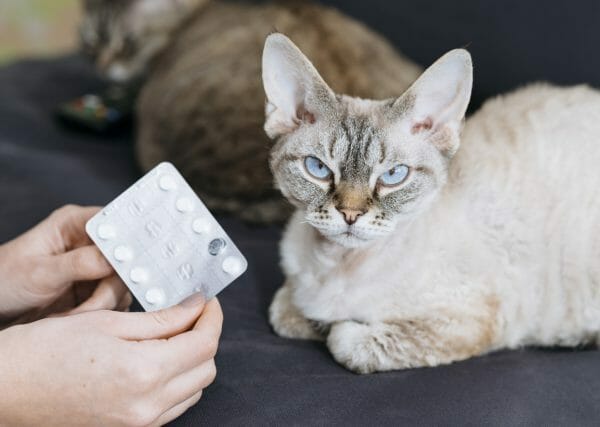
Surgery
Surgically removing the thyroid is known as a thyroidectomy. In this procedure, all or part of the affected thyroid gland is removed. The surgery is fairly straightforward and typically has good outcomes. Performing a thyroidectomy will usually cure the condition. Surgery is best used for younger cats with no underlying health conditions.
However, due to the invasiveness of the surgery and the possibility that it could damage the parathyroid glands, surgery is usually a last resort because less invasive treatment options are available. In addition, the surgery requires general anesthesia, which can be risky for older cats. If surgery is chosen as the treatment option, the cat will probably be treated with methimazole before surgery to alleviate the condition, bring up the cat’s weight, and stabilize the cat’s blood pressure and heart rate.
Cat Food for Hyperthyroidism
Another treatment option for cats with hyperthyroidism is a prescription diet that restricts iodine. The best cat food for hyperthyroidism is Hills Prescription Diet y/d. The food is not iodine-free, but it precisely controls the iodine content to 0.2 ppm—a minuscule amount. However, for the diet to work, this must be the ONLY food the cat eats. No treats or other food can be given.
Although this treatment option is fairly inexpensive compared to some of the others, it may not work for every cat. If a cat has other medical conditions that require supplements or medications, the diet will not work. Another downside is that a feline might not like the taste and reject the food. Finally, it may be challenging to pursue this specialty diet in a household with multiple cats.




